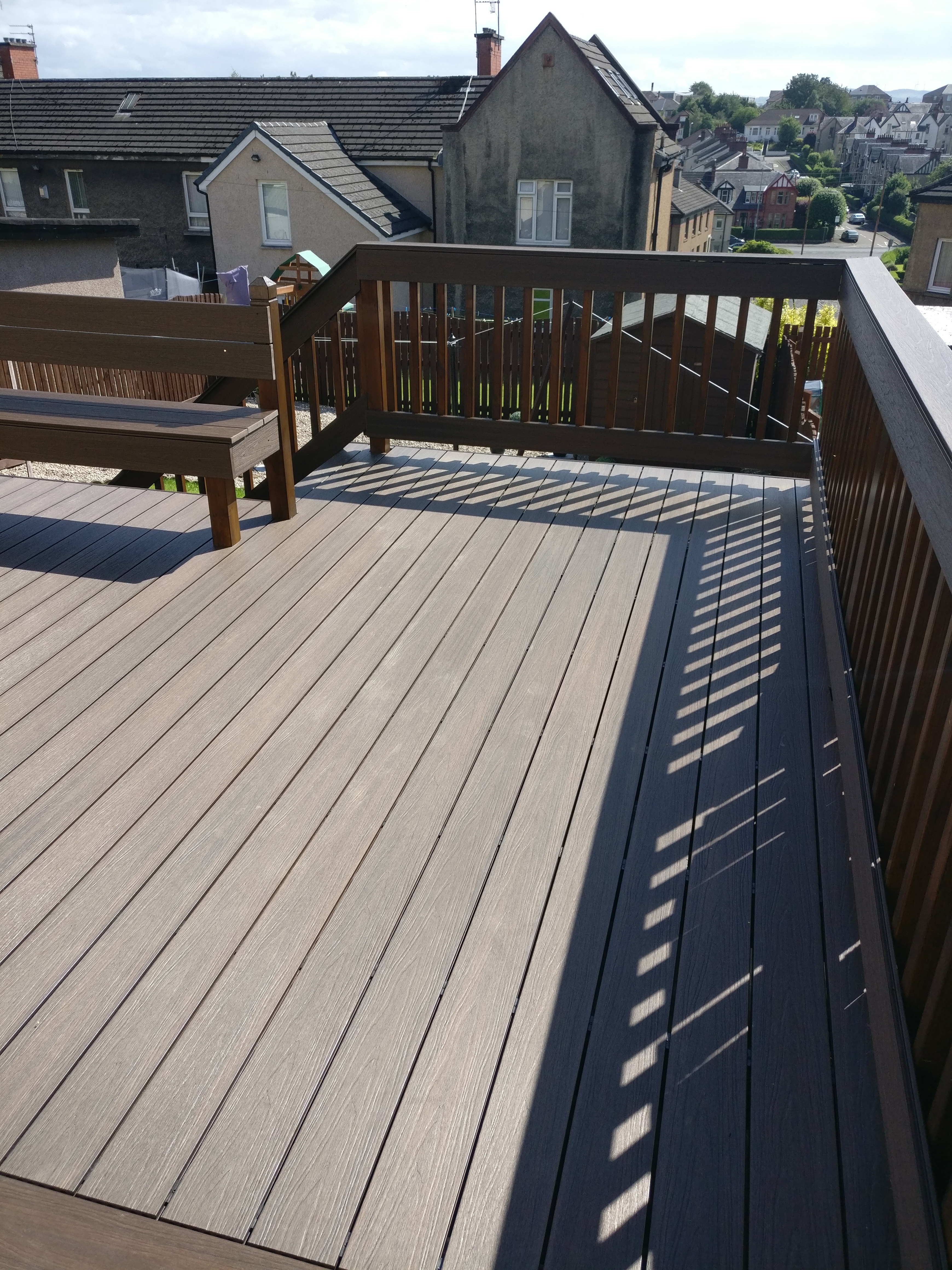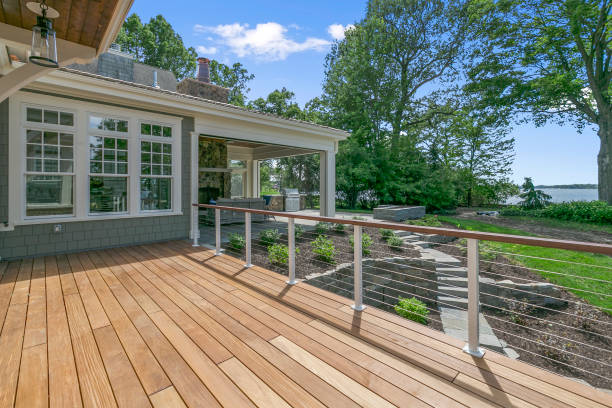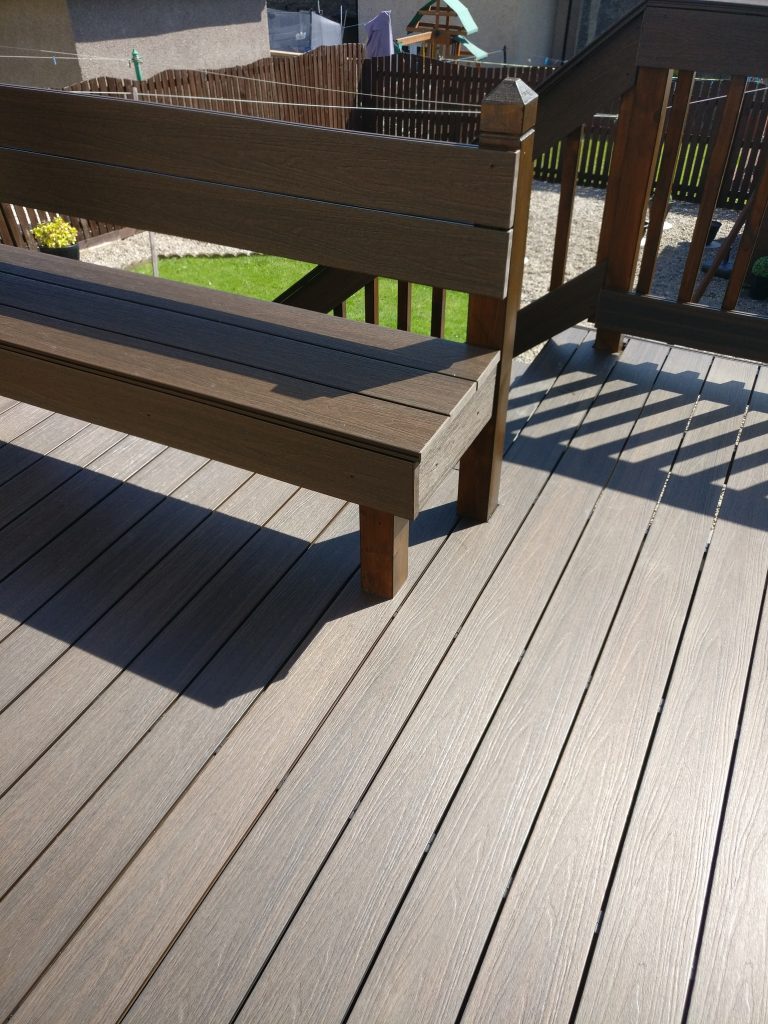Composite decking has been gaining popularity as a top choice for outdoor flooring, and it’s no surprise why. In this comprehensive guide, we’ll take an in-depth look at what composite decking is, how it’s made, its numerous benefits, and why it’s become such a sought-after option for homeowners. We’ll delve into the reasons behind its rising popularity, as well as the potential drawbacks to consider. We’ll provide valuable insights on how to properly maintain composite decking to ensure its longevity. Whether you’re considering installing composite decking or simply want to learn more about this trending material, this article has everything you need to know. Keep reading to discover why composite decking is currently the star of the deck-building world.
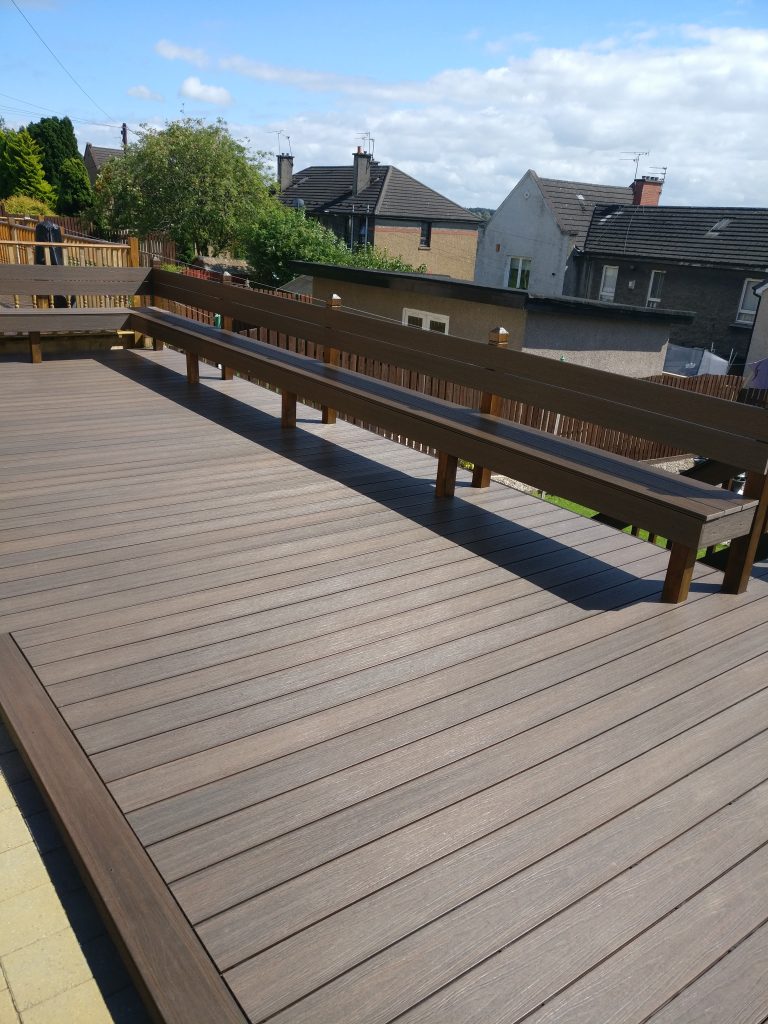
What Is Composite Decking?
Composite decking is a wood alternative that provides a durable and eco-friendly solution for outdoor living spaces, making it an ideal choice for outdoor construction projects.
It is created from a combination of wood fibres and recycled plastic, making it a sustainable option that minimises the environmental impact of deforestation and reduces the use of virgin plastic. Composite decking offers the natural look and feel of wood without the maintenance requirements, such as staining, sealing or painting.
Its resistance to rot, decay and insect damage makes it an excellent choice for outdoor environments, allowing homeowners to enjoy their outdoor living spaces with minimal upkeep.
How Is Composite Decking Made?
The production process of composite decking involves innovative technology and advanced construction techniques that combine various materials to create a durable and versatile decking material.
This involves the integration of wood fibres, plastic, and binding agents to form a homogeneous mixture. The materials are subject to high heat and pressure in a moulding process, resulting in a sturdy and long-lasting composite material.
Technological advancements have led to the development of co-extrusion methods, where a protective outer layer is seamlessly integrated during the manufacturing process, enhancing the durability and resistance to environmental elements.
These innovative manufacturing methods ensure that composite decking offers the natural aesthetic of wood, combined with the low-maintenance and durability of modern materials.
What Are the Benefits of Composite Decking?
Composite decking offers a multitude of benefits, including exceptional durability, low maintenance requirements, and a wide array of colour options, making it a popular choice for outdoor spaces in hot climates.
Its weather resistance ensures that it can withstand the harsh elements without warping, cracking, or fading, giving homeowners peace of mind and saving them from the hassle of constant upkeep.
The material’s versatility allows for a range of styles and designs, from traditional wood-like finishes to modern, sleek options, enhancing the aesthetic appeal of any outdoor area.
Its suitability for hot climates means that it remains comfortable to walk on, even on scorching days, making it an ideal choice for areas with high temperatures.
Little effort required to keep something in good condition
One of the key advantages of composite decking is its low maintenance nature, offering an eco-conscious solution for outdoor building materials that require minimal upkeep.
This type of decking is made from a blend of recycled wood fibres and plastic, contributing to the reduction of waste and deforestation. By utilising recycled materials, composite decking minimises its environmental impact and promotes sustainable practices. In addition, its durability and resistance to rot and warping reduce the need for frequent replacements, making it a more long-term, eco-friendly option for outdoor spaces.
Long-lasting
Composite decking is highly durable and resistant to various weather conditions, aligning with the latest outdoor construction trends that emphasise longevity and performance.
With a growing focus on sustainable and low-maintenance outdoor materials, composite decking offers a compelling solution for modern construction projects. Its ability to withstand the harshest elements, including UV rays, moisture, and temperature fluctuations, makes it an ideal choice for residential and commercial use. The demand for such resilient materials has surged in the industry, and composite decking stands out as a versatile, eco-friendly option that complements the shift towards long-lasting and visually appealing outdoor spaces.
Environmentally Friendly
Composite decking is an environmentally friendly choice, incorporating sustainable practices, recyclable components, and responsibly sourced materials to reduce its environmental impact.
This type of decking is designed to minimise the use of natural wood and instead utilises recycled materials such as reclaimed wood fibres and plastics. By opting for composite decking, individuals contribute to the reduction of deforestation and the demand for virgin materials. Its long lifespan and low maintenance requirements reduce the need for frequent replacements, thereby conserving natural resources.
The emphasis on sustainable practices in its production aligns with the growing awareness of eco-consciousness and responsible material sourcing among consumers.
Variety of Colours and Styles
Composite decking provides a wide variety of colours and styles, offering diverse aesthetic options for outdoor building materials, enabling versatile design choices for outdoor spaces.
These options allow individuals to create a customised look for their outdoor spaces, whether they prefer a natural wood-like appearance or a more contemporary and sleek design. From rich browns to cool greys and various grain patterns, composite decking offers the visual appeal of wood without the maintenance, while also providing the flexibility to complement different architectural styles and landscaping themes.
Such diversity in colour and style empowers homeowners and designers to achieve their desired outdoor aesthetic with ease and durability.
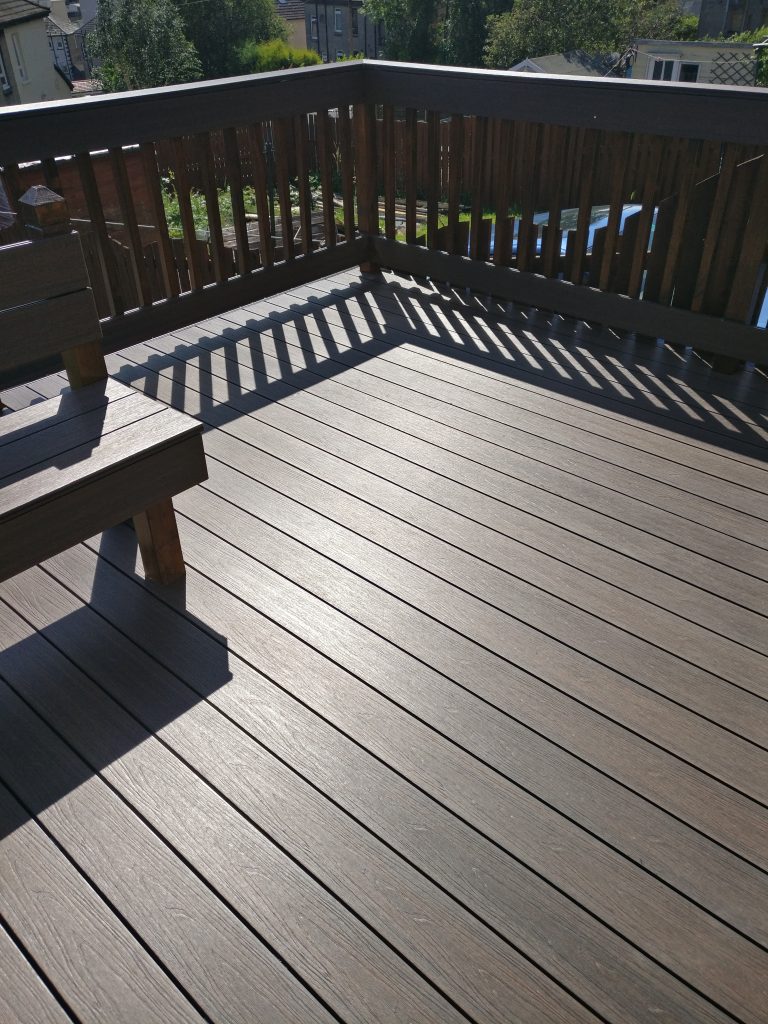
Why is composite decking so popular?
The popularity of composite decking stems from its exceptional resistance to heat and moisture, coupled with its ease of installation, driving significant market growth in the industry.
This innovative decking material offers a durable and low-maintenance alternative to traditional wood decking, making it a highly sought-after choice among homeowners and contractors alike. The ability of composite decking to withstand extreme temperatures, resist fading, and repel moisture ensures long-term performance without the need for constant upkeep or refinishing. As a result, the demand for composite decking has surged, reflecting an industry-wide shift towards superior, long-lasting materials that cater to the modern consumer’s desire for efficiency and quality.
Resistant to Heat
Composite decking exhibits remarkable resistance to heat, delivering high performance and suitability for various outdoor building projects in diverse environmental conditions.
This exceptional heat resistance makes composite decking an ideal choice for decking, fencing, and other outdoor applications in regions with extreme temperature fluctuations. Its durability and stability in both humid and arid climates ensure long-lasting performance, making it a preferred option for residential and commercial projects alike.
Whether it’s a beachfront boardwalk exposed to relentless sun or a mountain lodge enduring harsh winters, composite decking stands up to the challenge, offering a low-maintenance, visually appealing solution for diverse outdoor environments.
Resistant to Moisture and Mold
Composite decking’s resistance to moisture and mould makes it an ideal choice for outdoor renovation, adding value to homes and enhancing outdoor living spaces with its protective qualities.
This type of decking is designed to withstand harsh weather conditions, preventing the growth of mould and mildew, which often plague traditional wood decking. By opting for composite decking, homeowners can minimise the need for frequent maintenance and enjoy a durable, long-lasting outdoor living area.
The low-maintenance requirements and long-term resilience against moisture make it a cost-effective and attractive addition to any residential improvement project, promoting an inviting and enjoyable outdoor space for years to come.
Easy to Install
Composite decking is easy to install, making it a valuable choice for outdoor investment and an enhancement to the home exterior with its quick and efficient installation process.
It’s no wonder that homeowners and contractors are increasingly turning to composite decking for their outdoor spaces. The straightforward installation process saves time and effort, providing a beautiful and functional addition to any home. This durable material not only enhances the aesthetic appeal of the outdoor area but also adds value to the property.
With its low-maintenance nature and resistance to rot, mould, and pests, composite decking proves to be a long-term investment in enhancing the overall appeal and functionality of the home exterior.
Long Lifespan
Composite decking offers a long lifespan, ensuring outdoor durability and contributing to timeless outdoor design, aligning with the demand for enduring outdoor construction materials.
It is a valuable material for creating outdoor spaces that can withstand the test of time while maintaining their aesthetic appeal. Composite decking’s resilience against weather, rot, and insects makes it a popular choice for homeowners seeking a low-maintenance, long-lasting solution. Its versatility allows for the creation of various outdoor designs, from traditional to contemporary, ensuring that the investment in composite decking pays off in both practicality and visual appeal.
What Are the Drawbacks of Composite Decking?
Whilst composite decking offers numerous benefits, it also presents certain drawbacks, such as potential higher upfront costs, susceptibility to being slippery, and the risk of fading or staining over time.
These drawbacks often lead to concerns for homeowners looking for a low-maintenance outdoor solution. The higher upfront costs of composite decking can be a deterrent, especially when compared to traditional wood decking.
The susceptibility to become slippery, especially when wet, raises safety concerns, requiring extra caution and potential additions like anti-slip inserts. The risk of fading or staining over time can diminish the aesthetic appeal, necessitating regular maintenance and additional expenses to keep the decking looking its best.
Higher Upfront Cost
One potential drawback of composite decking is the higher upfront cost, which may require a significant investment initially, but offers long-term benefits and a favourable return on investment for outdoor spaces.
The initial investment can be seen as a worthwhile one, considering the durability, low maintenance, and longevity of composite decking. Over time, the reduced need for repairs, staining, and replacements can lead to significant cost savings. The enhanced aesthetic appeal and added property value that composite decking brings can further contribute to a positive return on investment in the long run.
Can Be Slippery
Slippery surfaces can be a safety concern, especially in areas where an outdoor lifestyle is predominant. This issue is especially relevant in outdoor spaces where people gather for activities such as barbecues, pool parties, or leisurely gatherings.
Incorporating slip-resistant features into composite decking can significantly reduce the risk of accidents, ensuring that outdoor living spaces remain safe and enjoyable for all. Implementing safety measures, such as textured surfaces, non-slip coatings, or patterned designs, can enhance the grip of composite decking, providing peace of mind for homeowners and their guests.
Considering the impact of weather conditions on slippiness is vital, as moisture, rain, or dew can further exacerbate the risk. Therefore, prioritising slip resistance in the design and maintenance of composite decking can greatly contribute to creating safer outdoor environments.
Can lose colour or become marked over time
Another drawback of composite decking is the potential for fading or staining over time, which can impact its appearance and suitability for outdoor entertainment spaces, requiring regular maintenance and care. This can be particularly concerning in outdoor entertainment areas, where the decking is exposed to harsh weather conditions and frequent foot traffic. Without proper care and maintenance, composite decking can lose its vibrant colour and aesthetic appeal, detracting from the overall ambience of the space. Therefore, it’s essential for homeowners to be proactive in protecting their investment by following manufacturer-recommended cleaning and care routines to extend the lifespan and visual appeal of their composite decking.
How to Maintain Composite Decking?
Effective maintenance of composite decking involves regular cleaning, avoidance of strong chemicals, and prompt attention to any damage, ensuring the preservation of its appearance and performance over time, often supported by warranty coverage.
Regular cleaning is crucial to prevent the accumulation of dirt, debris, and organic materials that can encourage mould and mildew growth. It is recommended to use a soft-bristle brush or a gentle pressure washer to remove surface dirt. Strong chemicals should be avoided as they can cause discolouration and damage to the protective surface. Prompt repair of any scratches or cracks using manufacturer-recommended products is essential to prevent water penetration and further deterioration.
Most composite decking products come with warranty coverage, providing additional assurance for long-term preservation when proper maintenance practices are followed.
Regular Cleaning
Regular cleaning is essential for maintaining the appearance and integrity of composite decking, ensuring its longevity and suitability as outdoor building materials for various applications.
It is crucial to remove dirt, debris, and organic materials that can accumulate on the surface, as these can lead to discolouration, mould, and mildew growth, compromising the aesthetics and structural integrity of the decking. By incorporating a cleaning routine, homeowners and outdoor enthusiasts can preserve the beauty and functionality of their outdoor living spaces, ultimately enhancing the overall outdoor experience and protecting their investment in composite decking.
Avoid Harsh Chemicals
Avoiding the use of strong chemicals is crucial for the maintenance of composite decking, preserving its natural appearance and eco-friendly qualities while ensuring its long-term durability and attractiveness.
This type of decking material is designed to mimic the appearance of natural wood while being more sustainable and resistant to decay, mould, and woodworm. By choosing eco-conscious maintenance practices, such as using mild cleansers and natural oils, homeowners can protect the integrity of their composite decking without harming the environment. This approach not only helps in maintaining the decking’s visual appeal but also aligns with the principles of eco-friendly living and material preservation that are increasingly sought after in modern construction and home improvement projects.
Address Any Damage Promptly
Promptly addressing any damage is essential for preserving the performance and visual appeal of composite decking, contributing to the overall quality of outdoor design and ensuring long-term satisfaction with the material.
Composite decking, being an integral part of outdoor spaces, requires proactive maintenance to uphold its structural integrity and aesthetic allure. Timely repairs prevent minor issues from escalating into costly problems, safeguarding the longevity and durability of the decking. Neglecting damage can lead to compromised safety and detract from the inviting ambiance that outdoor spaces aim to create.
By promptly attending to any damage, homeowners can extend the lifespan of their outdoor living areas while maintaining a visually pleasing environment.

